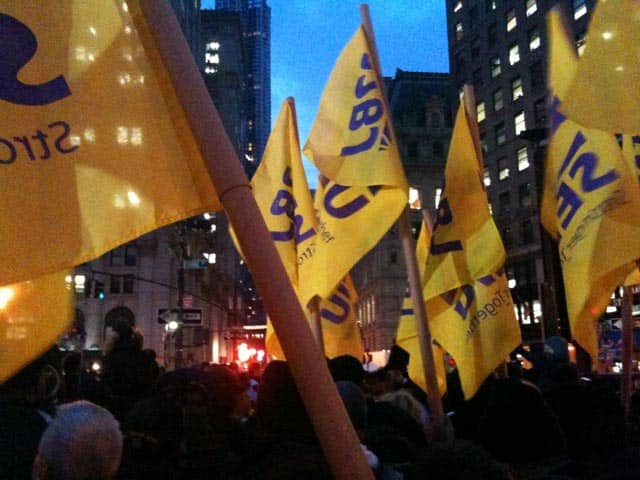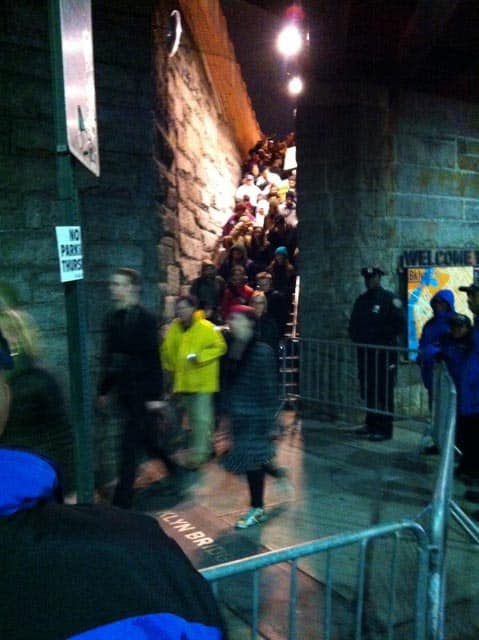Thirty years before the birth of the Occupy Wall Street movement, President Reagan fired enough striking air traffic controllers to fill a protest march across the Brooklyn Bridge (11, 345 PATCO members, to be exact). And in the three decades since Reagan famously said “if they do not report for work within 48 hours, they have forfeited their jobs and will be terminated,” U.S. worker participation in organized labor has precipitously fallen.
According to the Bureau of Labor Statistics, the 2010 union membership rate declined from 12.3 percent to 11.9 percent (the number of wage and salary workers belonging to unions dropped by 612,000 — to 14.7 million). During Reagan’s first term, the union membership rate was almost double what it is today (20.1 percent in 1983, the first year of comparable statistics).
In the intervening years since “The Gipper,” organized labor has occasionally practiced a more aggressive resistance. During the mid-1990s, trade unions (unsuccessfully) raised their collective voices against the North American Free Trade Agreement (NAFTA). UPS workers led a labor-invigorating strike in 1997. Two years later, organized labor collaborated with student, environmental, and other groups for the pre-hashtag N30 World Trade Organization (WTO) protests in Seattle. But the mid-to late-1990s activist spirit largely evaporated — at least in its public demonstrative formation — on September 11, 2001, when activism was traded in for patriotism by a large percentage of working-class Americans.
Yet, in a quotation from Facing Reality that I am known to often repeat, “[P]eople all over the world, and particularly ordinary working people in factories, mines, fields, and offices, are rebelling every day in ways of their own invention. . . . Their strivings, their struggles, their methods have few chroniclers.” And it has been this kind of rebelling — in the decade since 9/11 and especially in the years since the global economic crisis that we find ourselves still so deeply mired in — that has been slowly but firmly reinvigorating the spirit of resistance in “ordinary working people.” The resistance began using “occupation” techniques at the Republic Windows and Doors factory in Chicago in 2008 and again at the State Capitol building in Madison, Wisconsin earlier this year.
For the past two months, I’ve been writing a series of pieces on working people, Occupy Wall Street, and organized labor (both here in the U.S. and the international trade union movement). I’ve spoken to a wide variety of rank-and-file workers and trade union leaders about the role organized labor might play in relation to the #OWS movement. And I’ve been asking, over and over, that most famous of questions: what is to be done?
Instead of going from Zuccotti Park to the Union Square protests yesterday, I decided instead to head straight to Foley Square in the early afternoon. At an hour when the NYPD was just beginning to set up the metal barricades, members and organizers of various trade unions began arriving. By 4:00pm, I found myself awash in a sea of purple and yellow SEIU 32BJ flags and elongated purple 1199 SEIU banners. As one 1199 SEIU member in the square said to me, “Nothing like this ever before. Nothing.”
The stage in Foley Square transformed by the minute. From shoutouts that DJ Kool Herc also occupied a park in his day (and that occupation was the birth of hip hop) to a performance by a retired workers’ labor chorus to announcements that students and marchers were arriving from Union Square, the stage was only missing one thing: purple prose speeches by labor leaders. Labor at Foley Square was choreographed in a new way, with labor providing the sound system for the human microphone and the warm bodies of working people to protest with the #OWS crowd — the same working people who had previously been, by themselves, “rebelling every day in ways of their own invention” against this shattered economic system. Labor was beginning, it seemed, to re-imagine their relationship to geography and to space, thanks to Occupy Wall Street.
By the time we began our next move — this time choreographed by the NYPD’s metal barricades — to the Brooklyn Bridge, workers from a wide variety of unions were marching. According to various reports, this included 1119 SEIU, SEIU 32BJ, CWA, DC 37, CSEA, TWU, AFT, UAW, RWDSU, Retail Workers, Hotel Trades Council, Teamsters, Local 3 of Electrical Workers, Plumbers Union, Air Conditioners Union, and PSC-CUNY Professors.
I was just behind the SEIU flag-bearers when we began crossing the bridge. Among the most moving moments of the night was watching and listening to the response of placard-carrying Verizon workers as they leaned over the railing of the bridge to take in the projections on the Verizon building. “Goddamn brilliant,” I heard one Verizon worker say with a crack in his voice.
At the end of the bridge, marchers were funneled through a narrow staircase. “You know what I hope is at the end of those stairs?” one of the flag-bearers said to the person walking next to him. “A beer.” I’ve heard lines like that in union halls for years, but here’s what made all the difference on #N17: the line came not at a tiny monthly membership meeting in some union hall in Bakersfield or Brooklyn or Buffalo, but at the end of an historic day for labor, with thousands upon thousands of working people having just taken to the streets of New York.
Here’s hoping that when that flag-bearer, and many of the other 32,500 people who rallied at Foley Square, eventually got to raise that beer, they toasted with a line from the Verizon building projection: “It is the beginning of the beginning.”
Mark Nowak is the author of Coal Mountain Elementary (Coffee House Press, 2009) and Shut Up Shut Down (Coffee House Press, 2004). Read his blog Coal Mountain at <coalmountain.wordpress.com>.
var idcomments_acct = ‘c90a61ed51fd7b64001f1361a7a71191’;
var idcomments_post_id;
var idcomments_post_url;


